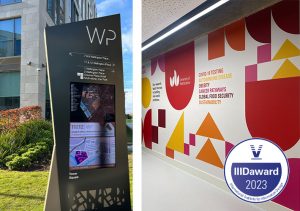A university is a brand. Often with a strong heritage but perhaps wanting to convey modernity or reflect its field of study. Definitely needing to communicate the impression of being well-organised, effective and welcoming.
And when a university has grown organically, perhaps over a few centuries, encompassing buildings of different designs dotted around an area, signage may be the only branded element to a campus. Wayfinding is therefore an opportunity for universities to brand their campus as well as a way to help people find their way to their destination.
We’ve had fun doing this with King’s College London where we created wayfinding to showcase the excellence of their teaching and their resources. We used the university’s image library and quotations from their academics to create wayfinding branding that showcases their research, their thinking and therefore their uniqueness.
We use the branding style on hoardings when the university is conducting building and refurbishment projects and to create window decals for the exhibition space in their Faculty of Social Sciences. As the building is listed, we managed the application for listed building and advertising consent from the local authority. Working with universities can indeed be complex as well as being fun.
We’ve also worked with Manchester Metropolitan University where our vibrant wayfinding stresses the vibrancy of the modern university. And we’ve worked with Bartlett School of Architecture where we playfully addressed its architectural legibility showing large scale floor numbers and architectural floor plans at key decision points. After all, this is the language their users speak and as we are architect founded, it’s our language too.
And of course, the wayfinding has to work to enable people to find their way around. For King’s College London’s listed Maughan Library, this involved devising stencilled wall signage to avoid drilling into its heritage structure and designing signage which worked with its frequently-evolving layouts, using paper inserts on wall maps so that signage can be updated by library staff.
We need good building names and naming conventions that work for the present and for future needs. When we worked with Oxford Brookes University we developed abbreviations and codes that identified the buildings, we are confident that the convention will work for their current ten year plan and for their ten year plan may be 100 years from now.
We also consider how people arrive and leave a university, which means we may include tube stations and bus routes on maps. We know that guests coming for a lecture, a meeting, or an interview as well as agency workers are grateful for these prompts. We know that students, perhaps living away from home for the first time, are grateful for these prompts. We know this because they frequently tell us during consultations.
Our recommendations for good wayfinding are to consider the needs of all of the end users: campuses are places where people work, rest and play and by engaging with all end users you can learn how people get around, what routes are the most popular, where people need help. Wayfinding needs to be fit for the future, using naming conventions that can evolve as your campus does.
And lastly, good wayfinding helps to tell the story of your university, helping people understand what makes it unique. With the university market becoming increasingly competitive this is more important than ever.
If you’d like visitors to connect better with your place, get in touch to discuss how we can help, on 0161 241 3174




